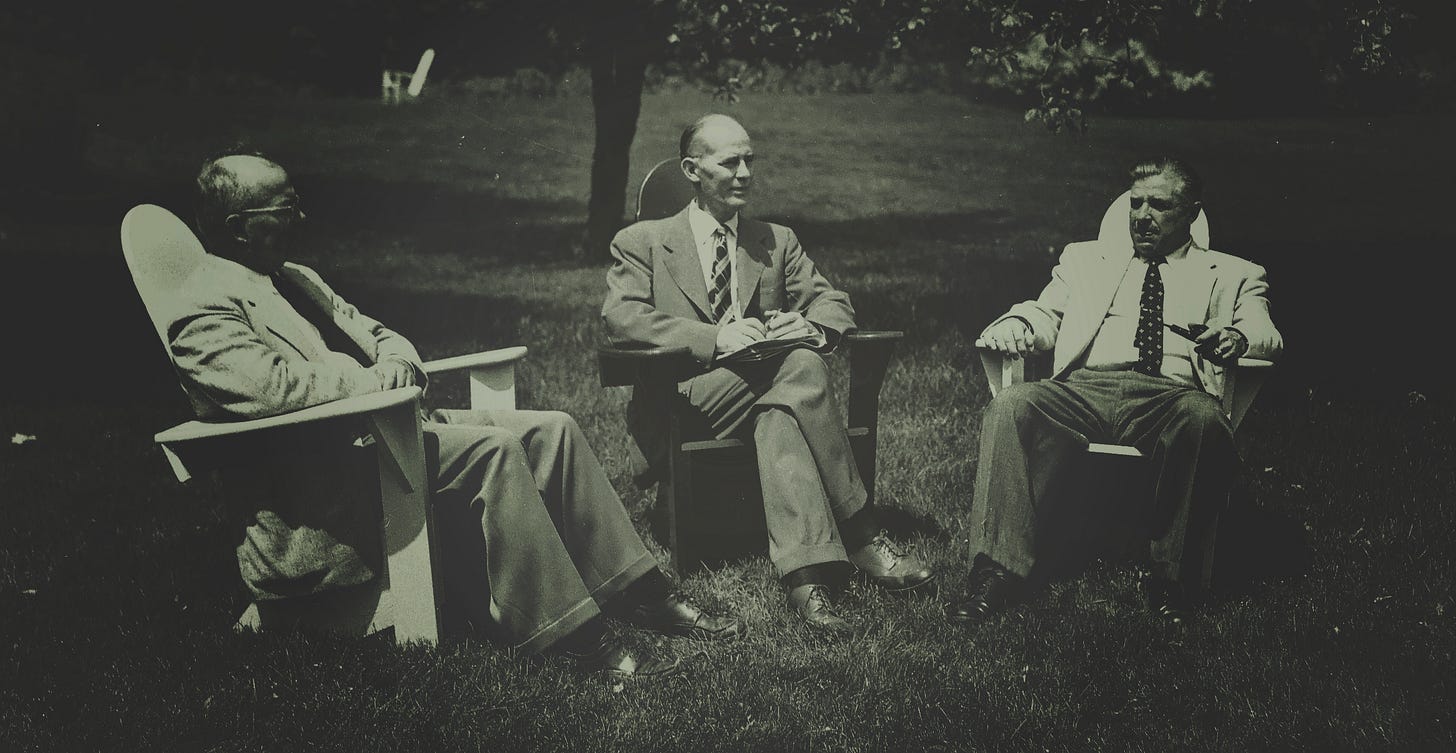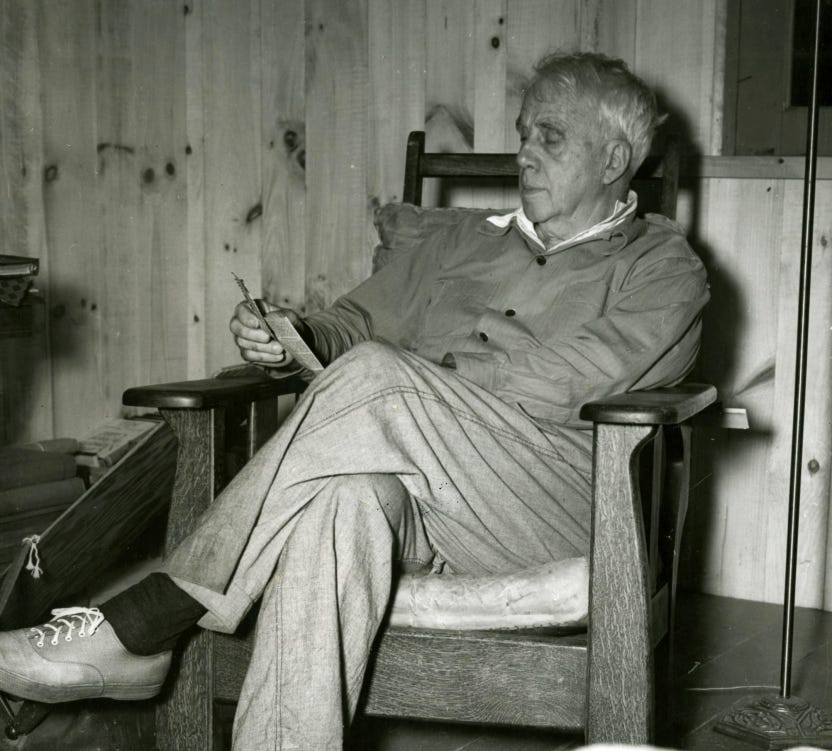A Man Shall Not Live at Bread Loaf Alone
From the Shelves: Donald Davidson and Robert Frost
On my shelf sits a particular volume of a special provenance, what I believe to be Robert Frost’s copy of Still Rebels, Still Yankees by Donald Davidson. Proof? It'll reveal itself in time. My path isn’t straight nor hurried.
PRAH-vuh-nuhns: The history or pedigree of a work of art, manuscript, rare book, etc.; concr., a record of the ultimate derivation and passage of an item through its various owners. A distinction is often drawn between the ‘origin’ and the ‘provenance’ of an article. (Oxford English Dictionary)A crossing occurs when one shifts from the mere buying of books to their collection. Eyes sharpen, tastes distill. Unless you're counted among the empty men, those billionaires masquerading in human sheaths, who farm out their collecting to mercenaries in exchange for piles of cash, your sights are probably not set on modern first editions or transient must-haves dictated by New York's arbiters of cultural worth.
There's a prevailing notion that, as a collector of Southern artifacts, I'd snatch up any book related to the region, or that the older the book, the more it appeals to me. Nope. And my focus doesn't center on the War, it's a few years in a saga that spans centuries.
Truth is, I aim to clear out many Civil War volumes, making room and providing funds for the essence of my collection: association copies. But not just any. I seek those scarce editions, inception copies, where the associations are layered, preserved like the delicate imprints of ancient leaves embedded in sedimentary rock.
An association copy is a book that an author has signed and personally inscribed to someone of note, distinguishing it from regular inscribed copies. Collectors value these copies for their historical and contextual significance and rarity.
The book in question is inscribed: “For the Homer Noble Farm library—This book belongs where the title essay started, one summer in the 1930’s. Best regards to all. Donald Davidson, August 21, 1957.”
Over time, a narrowly focused collector will likely eclipse the expertise in the specific of most booksellers. “Of making many books there is no end,” and the booktrader's clock ticks too swiftly to research every volume they encounter. I’d wager few bookshop employees are familiar with the rise of Bread Loaf, Donald Davidson, the history of his essay “Still Rebels, Still Yankees,” why he’d inscribe a book to a farm with a library, and how Robert Frost is connected in any of this. Just so happens, I can rotate these nodes and edges in my mind.
Bread Loaf
In the heart of Vermont’s Green Mountains, sits Bread Loaf, part of Middlebury College. Founded in 1920, as a summer school where minds gather to delve deep into English studies, earning their master’s degrees. In 1926, the Bread Loaf Writers’ Conference was established. Robert Frost was a pillar of the Bread Loaf School and its writers' conference, delivering two esteemed poetry readings each summer. After acquiring the Homer Noble Farm in 1939, near the campus, he spent much of the year there, deeply engaged in Bread Loaf's academic and cultural endeavors. Louis Untermeyer famously remarked, “Bread Loaf is the most Frost-bitten place in America.”1
The 20th-century Southern academic great replacement was a thing, basically “Sherman’s March through the Institutions.”2 At Vanderbilt, Davidson felt a deepening alienation. However, in the summer following the release of I'll Take My Stand, Bread Loaf offered Davidson respect and refuge, where he stayed with the respected farmer, Homer Noble.3
Davidson found Bread Loaf in 1931 to be a much more hospitable environment than Vanderbilt. Not only was the area itself more rural, but his colleagues were more congenial. While failing to share his fierce Southern loyalties, they did not perceive those sentiments as either a threat or an embarrassment. (The New South types at Vanderbilt saw them as both.) In the official history of the Bread Loaf Writers’ Conference, the authors mention the ‘Ten O'Clock Rule’: It was forbidden that anyone could discuss the Civil War after ten at night, on pain of expulsion from the faculty club and payment of a fine, the amount of which varied.”4
Returning to the inscription, we've now met Homer Noble and linked him to Davidson. It’s known Frost purchased Noble's farm following Noble’s death. I'll briefly cover the "title essay" before exploring the bond between Davidson and Frost.

I covered the essay "Still Rebels, Still Yankees" a few years ago, so no need to replow that field. Regarding the inscription, it's essential to know that Cousin Roderick and Brother Jonathan, as depicted in the title essay, bear loose semblance to John Donald Wade and Homer Noble. Davidson makes several references to the Noble in his poems.5
Davidson and Frost6
In the winter of 1918–1919, in France, Davidson found Frost's poetry by candlelight. A decade later, they met in person after Frost's reading in Nashville. A car ride and a choice between dining at the Hermitage Hotel or a cafeteria, Frost preferring the latter, marked the start of a lifelong friendship.
In all likelihood, Donald Davidson and Robert Frost were the only members of the Bread Loaf community to support Strom Thurmond for president in 1948.
The camaraderie between Davidson and Frost at Bread Loaf deepened through the years. Frost would visit Davidson, his Scottish shepherd at his side. Their evenings were filled with music and breeze shooting. One memorable night, Frost arrived as Davidson played his dulcimer, sparking discussions that ranged widely, touching upon shared friends like Hervey Allen. Frost's Southern leanings, inherited from his Copperhead father (who named his son Robert Lee Frost), resonated with Davidson, creating a profound sense of kinship.
On January 29, 1963, Davidson learned that Robert Frost had died in Boston from heart failure and a blood clot in his lungs. “His like will not be again,” Davidson writes in his diary. “One of the last of the ‘Old Americans,’ even though he was in so many respects ‘modern.’ What a vacancy we shall feel at B[read] L[oaf]—for a long time—maybe it won’t be something we can ‘get used to.’”
1957
We return to Frost, I mean, my copy of Still Rebels, Still Yankees Davidson inscribed on August 21, 1957, published earlier that year in January by Louisiana State University Press. Davidson found no respite that summer. The news of his brother Tom's death in June marked the onset. The demanding political landscape of the South occupied his thoughts. His discussions with Frost on these issues were meticulously noted in his diary, concluding shortly before he inscribed the book in August.7
It's possible the details of that August day are tucked away in Davidson's private diary or a missed footnote in an uncommon book, yet it remains elusive. What's clear is Davidson and Frost shared many nights that summer at Homer Noble Farm, keeping to their tradition. Considering Frost’s books from the farm were cataloged and donated8, not sure how the reputable northern bookshop came by the volume where I found it online for a very low price. Searches for "Homer Noble Farm library" return void. I reckon someone from Bread Loaf might have the answer, but I appreciate a good mystery.
Further Reading
Bain, David Haward. Whose Woods These Are: A History of the Bread Loaf Writers' Conference, 1926-1992. United Kingdom: Ecco Press, 1993.
Baker, Carlos. “Frost on the Pumpkin.” The Georgia Review 11, no. 2 (1957): 117–31.
Bradford, M.E. “The Prophetic Voice of Donald Davidson” Chronicles Magazine, 1992.
Bread Loaf in 1957 and the Bread Loaf Commencement Address delivered August 10, 1957
Davidson at Bread Loaf. The Crumb 37, no. 22. July 26, 1956, and the 1957 The Crumb
Frost: Centennial Essays, Vol. 3. University Press of Mississippi, 1974. Frost’s cabin and bookshelves are described on page 133 and Peter J. Stanlis’ “Acceptable in Heaven's Sight: Robert Frost at Bread Loaf: 1939-1941” is a must.
Middlebury Special Collections results mentioning Davidson
Munford, Howard, and Robert W. Hill. “Howard Munford Remembers Robert Frost: An Interview.” The Robert Frost Review, no. 10 (2000): 125–44.
Paton, Priscilla. “Going and Coming Back: The Many Houses of Robert Frost.” The Robert Frost Review, no. 28 (2018): 11–25.
Pratt, William. “Donald Davidson: The Poet as Storyteller.” The Sewanee Review 110, no. 3 (2002): 406–25. Pratt mentions the Davidson/Frost friendship and their similarities.
Ransom, John Crowe Ransom. “The Most Southern Poet: Donald Davidson.” Sewanee Review 70, no. 2 (1962).
Reviews and mentions of Still Rebels, Still Yankees when it was first released.
Taylor University Magazine 1, no. 3 (1964).
What happened to the Homer Noble Farm after Frost’s death? Answer.
Also, Huey PDF Long archived for the 1st time Donald Davidson’s “Recollections of Robert Frost.” In Robert Frost and Bread Loaf (Limited Edition). Middlebury, Vt.: Middlebury College Press, 1964. No page numbers. CLICK ME
Stanlis, Peter J. Robert Frost: The Poet as Philosopher. ISI Books, 2007.
I need to write about this.
Winchell, Mark Roydon. Where No Flag Flies: Donald Davidson and the Southern Resistance. University of Missouri Press, 2000. Frost also roomed with Noble before he bought the Farm after Noble’s death.
Winchell
e.g. “Ninth Part of Speech: A Verse Letter: To Louis Zahner.” The Virginia Quarterly Review 36, no. 4 (1960): 533–37.
Quotes and narrative in this section come from Winchell, Where no Flag Flies.
Winchell







